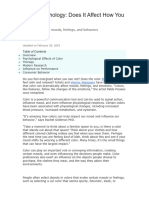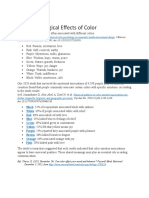The Psychology of Colours
The Psychology of Colours
Uploaded by
arsabanCopyright:
Available Formats
The Psychology of Colours
The Psychology of Colours
Uploaded by
arsabanOriginal Description:
Copyright
Available Formats
Share this document
Did you find this document useful?
Is this content inappropriate?
Copyright:
Available Formats
The Psychology of Colours
The Psychology of Colours
Uploaded by
arsabanCopyright:
Available Formats
The Psychology of Colour Color Psychology When selecting interior paint colors, it is important to consider the emotional effects
of the chosen color design. Colour psychology is the examination of colors and their influences on mental and physical states. While many interior designers utilize principles of color psychology when working with clients, there are also color consultants who specialize in color matching and the selection of interior paint colors. The Mind and Colour Because it is a fairly new area of investigation, colour psychology is looked at with some hesitation by the majority of psychologists. his is often because cultures around the world can have conflicting meanings for the same colors. !owever, ancient cultures such as the Chinese and "gyptians did believe in the healing powers of color and their effects on well#being. Colour consultants have also observed emotional reactions to colours in addition to physical responses. Because of these effects, color consultants feel that interior paint colors can have a considerable influence on the inhabitants of any space. he process of color matching based on each client$s situation will result in custom combinations of interior paint colours. he basic categories used by color consultants include% Warm colors # red, orange, and yellow. Cool colours # blue, green, and violet. &eutral colors # white, black, and gray. The Effects of Colour 's color consultants analyze a client$s personal interior design style, there are specific criteria that are used to ensure proper color matching for each client$s needs. !ere are some of the commonly accepted mental and physical connotations of interior paint colors% Red (ositive # passion, love, excitement, fire, strength, courage. &egative # anger, war, danger. "ffects # increased respiration, blood pressure, appetite, and metabolism.
Orange (ositive # happiness, endurance, stimulation, enthusiasm, determination, attraction. &egative # heat. "ffects # increased mental activity, appetite, and energy. Yellow (ositive # cheerfulness, sunshine, energy, joy, intelligence, honor. &egative # deception, cowardice, caution. "ffects # increased mental activity, awareness, and energy. Blue (ositive # tran)uility, loyalty, truth, depth, confidence, trust, sincerity, expertise, masculinity. &egative # depression, solemnity, coldness. "ffects # increased calm and satisfaction. Green (ositive # safety, nature, restfulness, growth, fertility, harmony, newness, security, money. &egative # greed, envy, jealousy, ignorance. "ffects # improved healing and relaxation. Violet (ositive # power, wealth, dignity, royalty, luxury, magic, wisdom, drama, mystery, ambition, creativity, femininity. &egative # snobbery, gloominess. "ffects # increased creativity and intuition. White (ositive # cleanliness, innocence, purity, kindness, light, simplicity. &egative # chilliness, sterility, emptiness. "ffects # increased sense of sophistication and sanitation. Black (ositive # formality, night, elegance, mystery, prestige, power. &egative # evil, death, fear, grief, depression. "ffects # increased sense of sophistication and depth. Gray (ositive # wisdom, atonement, intelligence, industry, futuristic. &egative # dreariness, storminess, boredom. "ffects # increased sense of sophistication and calm.
You might also like
- Anoaktree Edinburgh2005Document2 pagesAnoaktree Edinburgh2005Ariel GurevichNo ratings yet
- Color PsychologyDocument66 pagesColor PsychologyMarija Veljkovic82% (11)
- Color and Color PsychologyDocument39 pagesColor and Color PsychologyVarsha HeerNo ratings yet
- .Psychology of Colours in Building Design PDFDocument3 pages.Psychology of Colours in Building Design PDFRitika GuptaNo ratings yet
- The Meaning of Colors Book PDFDocument31 pagesThe Meaning of Colors Book PDFmutableS100% (1)
- Color TheoryDocument17 pagesColor Theoryapi-248221560No ratings yet
- Town-Planning PPT 2Document45 pagesTown-Planning PPT 2arsabanNo ratings yet
- MobilizationDocument46 pagesMobilizationarsaban50% (2)
- Part I: Research-Based Practice: DescriptionDocument5 pagesPart I: Research-Based Practice: DescriptionarsabanNo ratings yet
- Bill of Quantities - BOQDocument3 pagesBill of Quantities - BOQarsaban100% (1)
- Bamboo - WasteDocument12 pagesBamboo - WastearsabanNo ratings yet
- HSC Drama NotesDocument3 pagesHSC Drama NotesKen LongworthNo ratings yet
- Light Design by Anil ValiaDocument10 pagesLight Design by Anil ValiaMili Jain0% (1)
- Importance of Colour in BusinessDocument56 pagesImportance of Colour in Businessrameshmathur20No ratings yet
- Color PsychologyDocument3 pagesColor PsychologyRaven SynthxNo ratings yet
- How Color Define Workplaces - Research Paper - ZyetaDocument21 pagesHow Color Define Workplaces - Research Paper - ZyetaZyetaNo ratings yet
- The Perception of ColorsDocument58 pagesThe Perception of ColorsKhyn Mojica100% (1)
- Color Psychology2Document38 pagesColor Psychology2Goutam DebnathNo ratings yet
- Color PsychologyDocument17 pagesColor PsychologySuhail AhmedNo ratings yet
- Color Psychology: The Emotional Effects of ColorsDocument6 pagesColor Psychology: The Emotional Effects of Colorsvale paezNo ratings yet
- 10.2 Psychological Effects of ColorsDocument15 pages10.2 Psychological Effects of ColorsCarlo RosaioNo ratings yet
- The Impact of Color Psychology inDocument13 pagesThe Impact of Color Psychology inHarsh SrivastavaNo ratings yet
- Color Psychologyn Does It Affect How You FeelDocument6 pagesColor Psychologyn Does It Affect How You Feelsthakur101291No ratings yet
- Introduction To Color PsychologyDocument8 pagesIntroduction To Color PsychologylhousminlunNo ratings yet
- The Hidden Language of Color Exploring The Impact of Colors On Mind Brain and BodyDocument95 pagesThe Hidden Language of Color Exploring The Impact of Colors On Mind Brain and BodyAlbert William Olsen FladbyNo ratings yet
- Alexandra T. Manzano Bsn-Iii Ncm105: Personality Based On ColorDocument5 pagesAlexandra T. Manzano Bsn-Iii Ncm105: Personality Based On ColorAlejandro Lucena TrinidadNo ratings yet
- How Interior Design Affects Mood: Guide to Interior Spaces Impact on BehaviorFrom EverandHow Interior Design Affects Mood: Guide to Interior Spaces Impact on BehaviorNo ratings yet
- What Is Color PsychologyDocument5 pagesWhat Is Color PsychologyJessica PalasiNo ratings yet
- Final Compilation LalitDocument27 pagesFinal Compilation LalitLalit raj PurohitNo ratings yet
- IELTS General Training Reading Practice Test #5. An Example Exam for You to Practise in Your Spare Time. Created by IELTS Teachers for their students, and for you!From EverandIELTS General Training Reading Practice Test #5. An Example Exam for You to Practise in Your Spare Time. Created by IELTS Teachers for their students, and for you!No ratings yet
- The Power of Colors: Presented byDocument8 pagesThe Power of Colors: Presented byrupasree deyNo ratings yet
- 12 Color Meanings - The Power and Symbolism of Colors (Infographics)Document17 pages12 Color Meanings - The Power and Symbolism of Colors (Infographics)prince christopherNo ratings yet
- Color PsychologyDocument32 pagesColor PsychologyManuel RodillasNo ratings yet
- Psychology of ColorDocument19 pagesPsychology of ColorTrue SpiritNo ratings yet
- Interior Designing - Influence in Home DecoreDocument61 pagesInterior Designing - Influence in Home DecoreAshish MohantyNo ratings yet
- Colors and Their Effect On The MoodDocument33 pagesColors and Their Effect On The MoodMalakNo ratings yet
- Slidesgo Colorful Minds Understanding The Impact of Colors On Childrens Brain Development 20241126152120rSP7Document8 pagesSlidesgo Colorful Minds Understanding The Impact of Colors On Childrens Brain Development 20241126152120rSP7Harsh PawarNo ratings yet
- Color Psychology, Color Meaning, and Subliminal Messages in ArtDocument9 pagesColor Psychology, Color Meaning, and Subliminal Messages in ArtM Thali VR100% (1)
- Color Psychology 2795824Document7 pagesColor Psychology 2795824BhabaniNo ratings yet
- A Psycho-Linguistic Exploration of Color SemanticsDocument7 pagesA Psycho-Linguistic Exploration of Color SemanticsAtta RikaNo ratings yet
- Colour Psychology: Keywords: Colour Selection, Impact On The Human Mind, Psychological PropertiesDocument5 pagesColour Psychology: Keywords: Colour Selection, Impact On The Human Mind, Psychological PropertiesRitika GuptaNo ratings yet
- Color Meanings - Discover The Power and Symbolism Behind Every HueDocument1 pageColor Meanings - Discover The Power and Symbolism Behind Every Huejkknprbnc7No ratings yet
- Abdul Halim Numan, September 23Document1 pageAbdul Halim Numan, September 23hasan tareqNo ratings yet
- Interior Report-2Document44 pagesInterior Report-2p9m6q9dfwrNo ratings yet
- Orange Is The Color of Energy, Enthusiasm and Happiness. It Can Be Used To Bring An Attention To SomethingDocument2 pagesOrange Is The Color of Energy, Enthusiasm and Happiness. It Can Be Used To Bring An Attention To Somethingalyona telepovaNo ratings yet
- Colour PsychologyDocument20 pagesColour PsychologyVaibhav KudtalkarNo ratings yet
- Color Psychology (M)Document4 pagesColor Psychology (M)pak92103No ratings yet
- Color PsychologyDocument5 pagesColor PsychologymmadhvanNo ratings yet
- Exploring The Psychology of ColorDocument8 pagesExploring The Psychology of ColorEmiliano RondanNo ratings yet
- Color Affects The Way People FeelDocument3 pagesColor Affects The Way People FeelSanjay VengatravanaNo ratings yet
- Source Text, The Effect of Colors On Human PsychologyDocument12 pagesSource Text, The Effect of Colors On Human Psychologyred3dragon33333No ratings yet
- EXPERIMENT Final Write UpDocument31 pagesEXPERIMENT Final Write UpdevanshiNo ratings yet
- Color PsychologyDocument4 pagesColor Psychologyapi-552960429No ratings yet
- Color PsicologiaDocument6 pagesColor PsicologiaYesenia Sosa QuispeNo ratings yet
- Thesis Color PsychologyDocument5 pagesThesis Color Psychologyidmwergld100% (1)
- Workedcolor Assignment NewDocument12 pagesWorkedcolor Assignment NewkassahunNo ratings yet
- Color Psychology in Interior SpaceDocument4 pagesColor Psychology in Interior SpaceSamNo ratings yet
- Colors - The Emotions and Impressions They EvokeDocument7 pagesColors - The Emotions and Impressions They EvokeMy BuisnessNo ratings yet
- Color Schemes With Reference To Mood and SpaceDocument3 pagesColor Schemes With Reference To Mood and SpaceTayiba GhazalNo ratings yet
- Color PsychologyDocument3 pagesColor PsychologyDongdongie ChaNo ratings yet
- Colors, Like Features, Follow The Changes of The Emotions. - Pablo PicassoDocument14 pagesColors, Like Features, Follow The Changes of The Emotions. - Pablo PicassodaphnereezeNo ratings yet
- The Impact That Color Has On Human Psychology: By: Aliposa, Princess Joy Belbes, Jonas Zafe, Emily RoseDocument4 pagesThe Impact That Color Has On Human Psychology: By: Aliposa, Princess Joy Belbes, Jonas Zafe, Emily RoseMiguelita SantoceldezNo ratings yet
- Color PsychologyDocument16 pagesColor Psychologysam Abdullah0% (1)
- Color PsychologyDocument1 pageColor Psychologyterrysetiawan04No ratings yet
- (Thesis) Color Emotion in ArcDocument210 pages(Thesis) Color Emotion in ArcNurholis Setiawan100% (1)
- Impact of Color MarketingDocument7 pagesImpact of Color MarketingSara GibbsNo ratings yet
- Responsibilities of Principal Employer in CLA 1970Document2 pagesResponsibilities of Principal Employer in CLA 1970arsabanNo ratings yet
- Participant & Non Participant ObservationDocument4 pagesParticipant & Non Participant ObservationarsabanNo ratings yet
- Salient Features of The CLA 1970Document1 pageSalient Features of The CLA 1970arsaban100% (1)
- Kinds of ArbitrationDocument2 pagesKinds of Arbitrationarsaban100% (1)
- Chandigarh and Amritsar Town PlanningDocument32 pagesChandigarh and Amritsar Town PlanningarsabanNo ratings yet
- Interior Designing: Creativity UnleashedDocument19 pagesInterior Designing: Creativity UnleashedarsabanNo ratings yet
- Human Resource Management Draft ReportDocument25 pagesHuman Resource Management Draft ReportarsabanNo ratings yet
- Mattress RecyclingDocument4 pagesMattress RecyclingarsabanNo ratings yet
- Pre PPP Assgn No: 10 Exercise: Academic Session: 2010-2011 Year: FirstDocument2 pagesPre PPP Assgn No: 10 Exercise: Academic Session: 2010-2011 Year: FirstarsabanNo ratings yet
- Architectural Education and Its Manifestation in The ClassroomDocument37 pagesArchitectural Education and Its Manifestation in The ClassroomarsabanNo ratings yet
- Plumbing: Water Supply SystemDocument29 pagesPlumbing: Water Supply SystemarsabanNo ratings yet
- Glues & Adhesives For WoodsDocument1 pageGlues & Adhesives For WoodsarsabanNo ratings yet
- Data Collection: Basic Tools For Process ImprovementDocument46 pagesData Collection: Basic Tools For Process ImprovementarsabanNo ratings yet
- Final CommunicationDocument30 pagesFinal CommunicationarsabanNo ratings yet
- Glossary of Drainage TermsDocument9 pagesGlossary of Drainage TermsarsabanNo ratings yet
- GypsumDocument6 pagesGypsumarsabanNo ratings yet
- Estimation Theory: Navigation Search Statistics Signal ProcessingDocument1 pageEstimation Theory: Navigation Search Statistics Signal ProcessingarsabanNo ratings yet
- Estimation Guidelines and TemplatesDocument10 pagesEstimation Guidelines and TemplatesarsabanNo ratings yet
- Waste Water Industry: Management DairyDocument10 pagesWaste Water Industry: Management Dairyarsaban100% (1)
- Prospectus 2013-2014Document212 pagesProspectus 2013-2014arsabanNo ratings yet
- The Concept of National CinemaDocument12 pagesThe Concept of National CinemaScott BirdwiseNo ratings yet
- How To Use FontsDocument2 pagesHow To Use FontsQuả Chanh Chua LèNo ratings yet
- Pynchon Bookforum Summer 2005Document9 pagesPynchon Bookforum Summer 2005fistfullofmetal100% (1)
- Gabriel García MárquezDocument7 pagesGabriel García MárquezJose Andres Duitama ParraNo ratings yet
- English Fingering - Tenor RecorderDocument3 pagesEnglish Fingering - Tenor RecorderJuan Carlos Moreno Henao100% (1)
- 7777777777Document3 pages7777777777rodge_88No ratings yet
- Theatre Vocabulary - TEST (19!08!2009)Document17 pagesTheatre Vocabulary - TEST (19!08!2009)SheliaNo ratings yet
- Dua After Funeral PrayerDocument2 pagesDua After Funeral PrayerTitabur RahamanNo ratings yet
- Mise en Scene (Inc Lighting)Document41 pagesMise en Scene (Inc Lighting)Dee Watson100% (1)
- Ial Maths p3 Ex3aDocument2 pagesIal Maths p3 Ex3aahmed ramadanNo ratings yet
- Description MaleficaDocument3 pagesDescription MaleficaginaNo ratings yet
- Catalogo Tubertini 2014Document460 pagesCatalogo Tubertini 2014Oscar Spinningalicia0% (3)
- Scope Library LiterarytermsDocument4 pagesScope Library Literarytermsapi-283229700No ratings yet
- Wire Thermanit CSiDocument1 pageWire Thermanit CSiviphemantNo ratings yet
- Gill-Doctrinal Divinity of The Holy ScripturesDocument17 pagesGill-Doctrinal Divinity of The Holy ScripturesLawrence GarnerNo ratings yet
- Tongue TwisterDocument31 pagesTongue TwisterBelle RomeroNo ratings yet
- Art of Indus ValleyDocument10 pagesArt of Indus ValleyThejasvi AtmadasaNo ratings yet
- F&B Service Equipments - FamiliarizationDocument6 pagesF&B Service Equipments - FamiliarizationSIVA KRISHNA PRASAD ARJANo ratings yet
- The Duchess of MalfiDocument4 pagesThe Duchess of MalfiNoraNo ratings yet
- Visio Lign Toolkit GBDocument4 pagesVisio Lign Toolkit GBbuzatugeorgescuNo ratings yet
- Punk RockDocument59 pagesPunk RockSteve RadermanNo ratings yet
- DELTA New Products Price ListDocument4 pagesDELTA New Products Price ListAhsan HabibNo ratings yet
- Art App SyllabusDocument9 pagesArt App SyllabusJanine TupasiNo ratings yet
- Fate Magazine 281 v26n08 Aug 1973Document148 pagesFate Magazine 281 v26n08 Aug 1973Scottie Green100% (2)
- Simplicity 1102 InstructionsDocument4 pagesSimplicity 1102 InstructionsdidomessiNo ratings yet
- A Cultural History of The Avant-Garde inDocument54 pagesA Cultural History of The Avant-Garde inCarlos De Landa AcostaNo ratings yet
- Il Mio Tesoro: (Don Giovanni)Document4 pagesIl Mio Tesoro: (Don Giovanni)Raphaël Lamothe0% (1)


















































































































